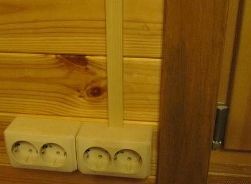Categories: Featured Articles » Electrician at home
Number of views: 24095
Comments on the article: 2
Internal wiring of a country house
 Internal wiring in country houses is most often performed open. Since the interior decoration in these houses usually includes decorative elements and natural wood paneling, the most typical cable route is plastic cable channel. After all, the open installation of cable lines on combustible surfaces is prohibited by the applicable PUE standards. At the same time, open cable laying in pipes or corrugated pipes on clips is rejected for aesthetic reasons.
Internal wiring in country houses is most often performed open. Since the interior decoration in these houses usually includes decorative elements and natural wood paneling, the most typical cable route is plastic cable channel. After all, the open installation of cable lines on combustible surfaces is prohibited by the applicable PUE standards. At the same time, open cable laying in pipes or corrugated pipes on clips is rejected for aesthetic reasons.
Regarding the choice of cable products for wiring in a country house, we can say that it is not particularly wide. In order not to have any problems afterwards, it is better to stop on VVG-ng copper cables (for those who want to save a little), or NYM (for those who are not limited in funds). See also -which cable to use for wiring in the house.
The chains of sockets are traditionally made with a cable with three conductors with a cross section of 2.5 square meters. mm., and the lighting circuit - a three-core cable with a cross section of 1.5 square meters. mm The cross-section of cables for powering stationary electric receivers, such as an electric stove, extractor hood, water boiler, is determined based on the power consumption and the phase of the receiver. Usually for any receiver, a cable with a cross-section of a 4-sq. mm
No one restricts the choice of cable channel for wiring the owner of a country house. In addition to traditional boxes of classic white or any other color (including wood for a variety of grades and shades), you can use special cable skirting boards and even cabinet furniture with integrated cable channels invisible to the eye.
However, for supporters of design minimalism, a rectangular white box with dimensions of 20 * 10 or 16 * 16 mm for laying single cable lines, for example, to a switch or socket, and a box with a cross section of 25 * 16 or 25 * 25 for trunk lines will be enough. In rare cases, when there are sections of the route where a large number of cables with a cross section of 2.5 square meters pass. mm or more, you may need a box with sizes 40 * 16, 40 * 25 or even 40 * 40 mm.
For fastening a plastic box to a wooden wall sheathing, it will be easiest to use a cordless screwdriver and 3.5 mm self-tapping screws with large thread (wood).
However, one should not think that hidden wiring in a country house is completely excluded. If the construction is made of brick, concrete, or any block non-combustible materials, then classic installation of hidden wiring in a stucco for plaster. And in a wooden house, hidden wiring in metal grounded pipes is allowed. Using plastic corrugated pipe for these purposes it is not allowed, but a metal pipe can be any. Details about this can be found here: Wiring in a wooden house
The main requirements for a cable route made of metal pipes are corrosion resistance of the pipe, the absence of sharp edges that can damage the cable sheath, and the absence of places where moisture can accumulate due to condensation. The first is achieved by using a pipe with a painted or galvanized inner surface, the second by using plastic liners at the exits, and the third by the presence of a small counterclone (as in a plumbing pipeline).
All pipe connections for electrical wiring must be made either by threaded couplings or by welding. Simple joints are not allowed.
It is quite obvious that installing concealed wiring in pipes takes a lot of time and effort. However, the result is often worth it.After all, such wiring meets all fire safety standards and does not spoil the interior of the room at all. For those who want to carry out hidden wiring in a country wooden house, with less effort and less material costs, there is another option - installation of wiring according to the outline of the plaster.
Of course, this installation method is applicable only for walls, the decoration of which is done not by sheathing, but by plaster. Plaster is in any case a material that does not support and does not spread combustion, therefore PUE is allowed to fasten the cable with brackets on a layer of this finishing material, and not directly on a wooden wall.
See also at e.imadeself.com
:
